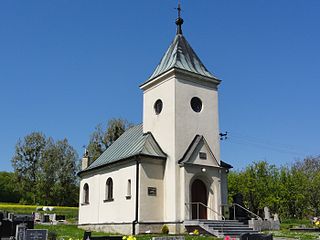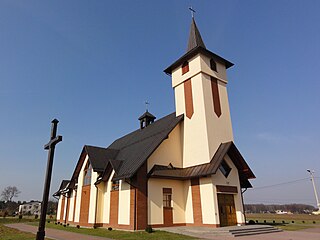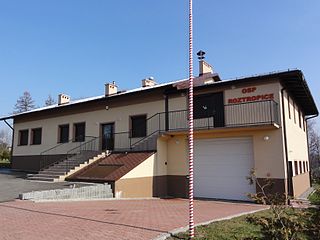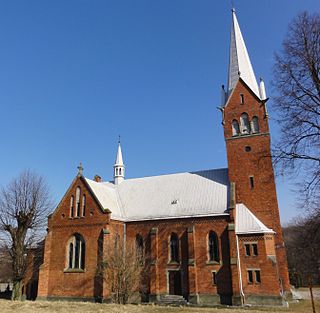
Czechowice-Dziedzice(listen), previously known until 1958 as Czechowice, is a town in Bielsko County, Silesian Voivodeship, southern Poland with 35,684 inhabitants as of December 2021. It lies on the northeastern edge of the historical region of Cieszyn Silesia. With four stations, it is a large rail junction, located at the intersection of two major lines – east-west, and north–south.

Brenna (help·info) is a village in and the seat of Gmina Brenna, Cieszyn County, Silesian Voivodeship, southern Poland, located in the historical region of Cieszyn Silesia. It is located in the Silesian Beskids mountain range, along the river Brennica, right tributary of the Vistula river.

Godziszów is a village in Gmina Goleszów, Cieszyn County, Silesian Voivodeship, southern Poland, close to the border with the Czech Republic. It has a population of about 600.

Zbytków is a village in Gmina Strumień, Cieszyn County, Silesian Voivodeship, southern Poland. It has a population of 1,262. It lies in the historical region of Cieszyn Silesia.

Zabłocie is a village in Gmina Strumień, Cieszyn County, Silesian Voivodeship, southern Poland. It has a population of 1,312 (2008) and an area of 19,03 km2. It lies in the historical region of Cieszyn Silesia.

Pierściec is a village in Gmina Skoczów, Cieszyn County, Silesian Voivodeship, southern Poland. It has a population of about 1,918. It lies in the historical region of Cieszyn Silesia.

Harbutowice is a village in Gmina Skoczów, Cieszyn County, Silesian Voivodeship, southern Poland. It has a population of about 880. It lies in the historical region of Cieszyn Silesia.

Kiczyce is a village in Gmina Skoczów, Cieszyn County, Silesian Voivodeship, southern Poland. It has a population of about 1127 and lies in the historical region of Cieszyn Silesia.

Kowale is a village in Gmina Skoczów, Cieszyn County, Silesian Voivodeship, southern Poland. It has a population of about 610 and lies in the historical region of Cieszyn Silesia.

Wilamowice is a village in Gmina Skoczów, Cieszyn County, Silesian Voivodeship, southern Poland. It has a population of about 543.

Świętoszówka is a village in Gmina Jasienica, Bielsko County, Silesian Voivodeship, southern Poland. It has a population of 618 (2016). It lies in the Silesian Foothills in the historical region of Cieszyn Silesia.

Iłownica is a village in Gmina Jasienica, Bielsko County, Silesian Voivodeship, southern Poland. It has a population of 1,018 (2016).

Landek is a village in Gmina Jasienica, Bielsko County, Silesian Voivodeship, southern Poland. It has a population of 601 (2016). Landek lies in the historical region of Cieszyn Silesia.

Roztropice is a village in Gmina Jasienica, Bielsko County, Silesian Voivodeship, southern Poland. It has a population of 755 (2016). It lies in the Silesian Foothills and in the historical region of Cieszyn Silesia.

Wieszczęta is a village in Gmina Jasienica, Bielsko County, Silesian Voivodeship, southern Poland. It has a population of 529 (2016). It lies in the Silesian Foothills and in the historical region of Cieszyn Silesia.

Łazy is a village in Gmina Jasienica, Bielsko County, Silesian Voivodeship, southern Poland. It has a population of 903 (2016). It lies in the Silesian Foothills and in the historical region of Cieszyn Silesia.

Grodziec is a village in Gmina Jasienica, Bielsko County, Silesian Voivodeship, southern Poland. It has a population of 1,256 (2016). It lies in the historical region of Cieszyn Silesia.

Mazańcowice is a village in Gmina Jasienica, Bielsko County, Silesian Voivodeship, southern Poland. It has a population of 3,745 (2016) and lies in the historical region of Cieszyn Silesia.

Zabrzeg is a village in Gmina Czechowice-Dziedzice, Bielsko County, Silesian Voivodeship, southern Poland. It has a population of 3,107 (2008).

Bronów is a village in Gmina Czechowice-Dziedzice, Bielsko County, Silesian Voivodeship, southern Poland. It has a population of 1,027 (2008). The village lies on the edge of the historical region of Cieszyn Silesia.
























